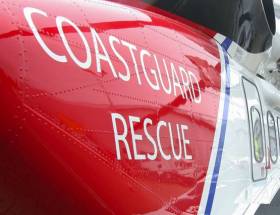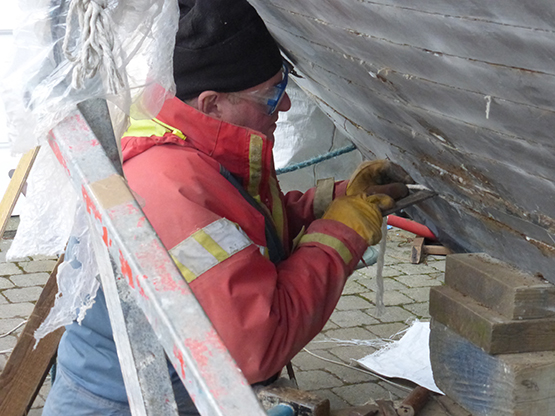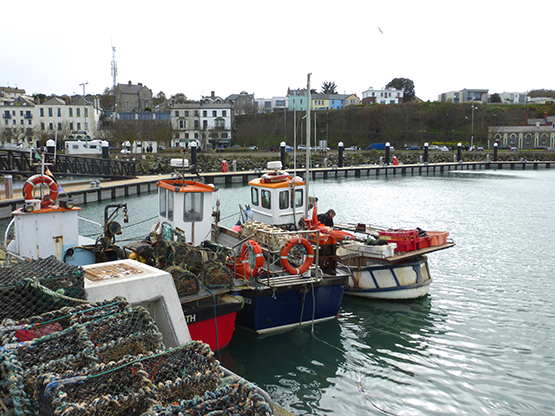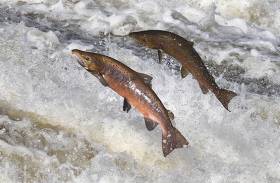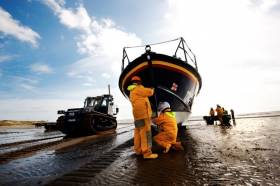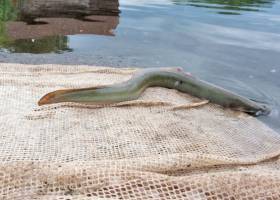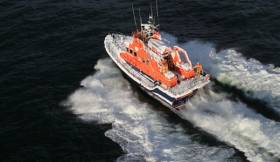Displaying items by tag: Fishing
#Search - One crew member from a fishing vessel has been rescued as the search continues for three others after the boat sank off Scotland's Western Isles in the early hours of this morning (Saturday 9 April).
The UK Coastguard received a distress alert just before 3:45am when the fishing vessel with four crew on board has its emergency positioning beacon (EPIRB) activated near Mingulay.
The coastguard search and rescue helicopter based at Stornoway has since been searching the area along with the Barra RNLI lifeboat.
One crew member has been taken to hospital by the helicopter. The lifeboat remains in the area and the coastguard helicopter from Prestwick has taken over so the search can continue.
Howth Harbour Thoughts From Home
This weekend has the Irish Sailing Youth Pathway Championships being staged at Howth, and despite the weather the place is buzzing. From being a harbour abandoned in embarrassment for twenty years in the middle of the 19th Century, the peninsula port has gradually evolved to develop a vibrant balance between fishing harbour, sailing centre, and visitor magnet. Longtime local W M Nixon tries to tell it like it is in Howth when seen from the inside.
Howth has most of the advantages and few enough of the disadvantages of being an island. Head home eastward through the isthmus at Sutton Cross (and don’t forget you’re heading eastward - Howth is Dublin’s Eastside, while the Northside is in nearby Ireland), and you shed your Irish identity to become a Howth person. Ideally, this means you become a complete nobody among many other nobodies, for that’s the way we like it.
It must be some sort of defence mechanism, for there was a period in the middle of the 1800s when the powers that be in nearby Ireland preferred to forget our very existence. You see, when the vital links of government between Dublin and London were being maintained by special sailing packet ships, Howth was important because the island of Ireland’s Eye (even in this blog we haven’t the space to explain how it got its name), which is upwards of half a mile off the distinctly rough village, was able to provide an element of natural shelter at a time when Dublin Bay and Dublin Port tended frequently to be disaster areas for shipping.
There were times when the only shelter in Dublin Bay itself was in the very limited space inside Dalkey Island, where a sailing ship could easily be trapped, whereas Howth Sound inside Ireland’s Eye, while north of Dublin Bay and beyond the Baily, nevertheless enabled a potentially embayed ship to cut and run. And yes, that is how the phrase originated.

The north side of Dublin Bay in 1692. The Government’s cross-channel packet boats favoured the roadstead anchorage at Howth inside Ireland’s Eye as it provided better shelter than the exposed bay itself, yet there was more space to cut and run than could be found in Dalkey Sound
Thus they built an inn in the village so that people passing through to London, and waiting for the packet boat, would not impose unduly on the hospitality at Howth Castle of the St Lawrence family, unless they were awfully important. And then when the engineer Thomas Telford was commissioned to build a road linking London with Dublin through Holyhead, naturally on the Irish side he followed the official view of things and continued his road through Howth and on towards Dublin, in light of the fact that offical policy was that the Government harbour would be built at Howth.
And build it they did, from about 1807 onwards, with John Rennie in charge. But with the gathering prosperity and increased trade after the final end of the Napoleonic Wars in 1815, the movement for the improvement of Dublin port and the building of an “asylum harbour” at Dunleary within Dublin Bay gained traction, and by 1817 what would soon become the highly-fashionable Kingstown Harbour was already under construction before Howth Harbour was even properly finished.

Once the new harbour had been completed at Dunleary on the south side of Dublin Bay and re-named Kingstown, the smaller shallower harbour at Howth was forgotten about for twenty years
Nevertheless Howth continued as the official mailboat port until 1834, by which time even the most stubborn official mind had to recognise that everyone else had long since gone Southside. So at last the powers that be followed. And in doing so, they tacitly agreed that the best way to deal with the memory of the ENORMOUS expenditure of building shallow sandy Howth Harbour was to ignore the place’s very existence for as long as possible.
The local fishermen continued to use the sandy creek of Balydoyle as their main port as they’d always done, while Howth seems to have been out of bounds to just about everyone. It was declared an inviolate Royal Harbour which might be of strategic value in the event of attack by Barbary pirates or Eskimo marine commando units or whatever, and for maybe fifteen years Howth simply slumbered, quietly silting up.
But by the 1850s, the growth of the fishing industry through travelling fleets of trawlers from the great fishing ports of Devon and Cornwall and Scotland and the east coast of England meant that increasing numbers of high-powered fishing skippers, almost entirely from Britain, were demanding that they be allowed to use Howth, and by the 1860s it had been designated a “Fishing Station”.
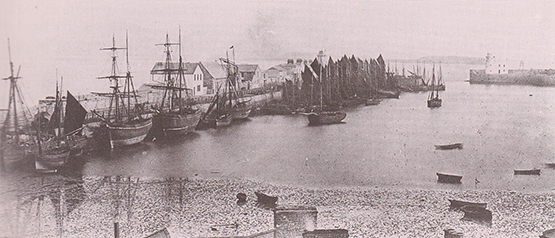
Howth Harbour in the 1870s, when it had become a “Fishing Station”
Much the same thing happened at Dunmore East, which was initially the packet boat port for Waterford, and the local fishermen weren’t really allowed into it at all. But then the advent of steamships meant the packet boats could go straight up to Waterford itself, and after an interval lying idle, Dunmore East also became a Fishing Station. But it was only because nobody else further up the pecking order had a use for it – in those days, fishermen were expected to fend for themselves.
So for thirty years and more, Howth was almost totally devoted to fishing, but in 1875 the famous Judge Boyd – he is referenced in Ulysses – took a lease on the harbourside Howth House which had originally been built as a residence for John Rennie, the engineer building the harbour. The Judge was well got, as his main house was in Merrion Square – it’s now the French Embassy – but as he was something of a maverick, he decided that he’d pursue his sport of sailing through Howth rather than Kingstown.

Judge Boyd was such a noted Dublin character that he was referenced in Joyce’s Ulysses

Thanks to Judge Boyd’s influence, Howth had a government dredger almost permanently on station from 1888 onwards. And for those who would seek further cultural references, the Yeats family lived in the house on the foreshore just to the left of the fishing boat from 1880 to 1882
A maverick he may have been, but he had influence in high places, and when the silting of Howth became even worse in the 1880s, hampering the seasonal activities of the travelling fishing fleets, the Judge saw to it that Howth got its own government dredger as an almost permanent feature.
The trouble is, the fishing was too successful – the herring were fished almost to extinction. By the 1890s, fleets visiting Howth were declining rapidly, but this in turn facilitated the development of the local sailing club, founded mostly by Judge Boyd’s sons in 1895.
However, the old Judge had lost none of his sparkle, for in 1892 he had bought the supposedly out-classed Fife 70-footer Thalia from the Clyde, and proceeded to win races left right and centre with her. Often he helmed her himself, but if he felt like a rest, the talented professional skipper who came with the boat was Owen Bissett, who stayed on in Ireland with such commitment that today one of Howth’s most able sailors, Ross McDonald, is Owen Bissett’s great-great grandson.
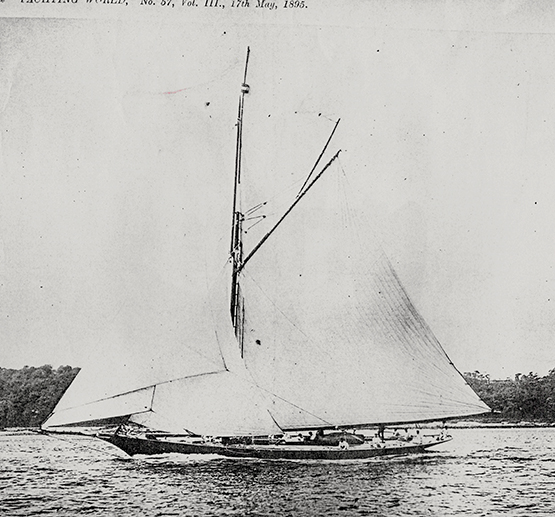
Judge Boyd’s Thalia racing in the Clyde – in Clyde Fortnight 1897 she won 140 pounds in prize money, the third highest in the regatta. Though he raced the boat himself, Judge Boyd also had a professional skipper in Owen Bissett, great great grandfather of today’s successful Howth skipper Ross McDonald
And if you wonder how the Judge managed to keep a large engineless yacht in little Howth Harbour, a yacht whose overall length from mainboom end to bowsprit end was well over a hundred feet, the answer is he treated Howth Harbour as if it was his private marina. After all, it was he who ensured it was dredged, so hadn’t he every right to keep Thalia in a very handy berth inside the nib on the West Pier? And if he happened to omit to retract Thalia’s long bowsprit which protruded well beyond the end of the nib, then heaven help any fishing skipper whose ancient craft managed to get fouled up in this exquisite piece of classic yacht equipment.

Regatta day at Howth, and Thalia in her berth inside the nib on the West Pier
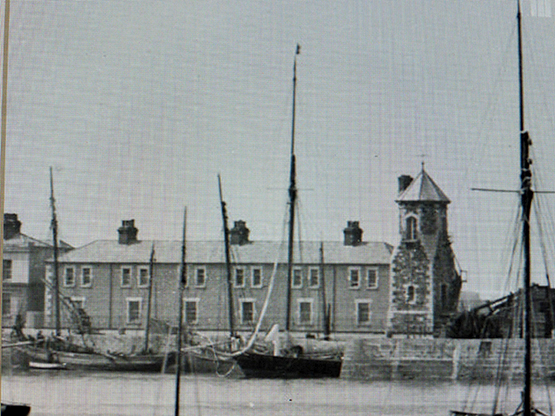
The perfect private berth – Thalia at the West Pier in Howth around 1900
It’s difficult to escape the feeling that the Judge’s four sons thought the old man was maybe a bit over the top, for in their new Howth Sailing Club they promoted the notion that “Small is Beautiful”. When the oldest brother Herbert designed the new one design class for Howth in the Autumn of 1897, the resulting Howth 17s were of very modest proportions, just 22ft 6ins in overall length.
In time, the mighty Thalia ceased to be a feature of Howth Harbour. She was of such a size that the easiest way to lay her up was a winter berth afloat in the Grand Canal basin in Dublin. But as she had been built on steel frames with copper fastenings, she was virtually on fire with electrolysis, and her days were short – by 1910 she had gone.
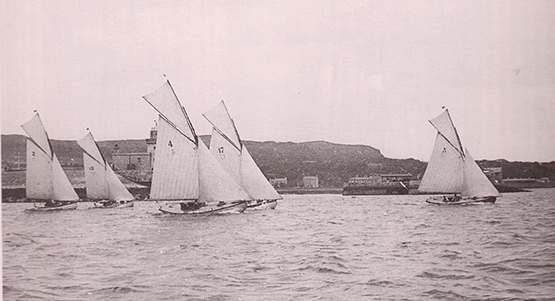
A much more modest proposition – the handy little Howth 17s were introduced in 1898, and they hope to have 18 boats racing this summer

From time to time, the Howth 17s add new boats – this is Erica and Isobel joining the fleet in 1988
The joys of classic yacht ownership…..Pat Heydon working in early March on the re-caulking of Gladys (built 1907), which he co-owns with Eddie Ferris and Ian Byrne. Photo: W M Nixon
But the Howth 17s plough steadily on 118 years later, thanks to a sort of group scheme of mutual help when a boat needs serious work done, with longtime owner Ian Malcolm as the multi-talented core of a sort of men and women’s shed movement with a maritime purpose. The purpose is to get in as much racing as they can, with as many boats as humanly possible. This season they’ll have 18 of them sailing, while a classic boat festival at Howth in early August has already roped in Mermaid Week, and they and the Seventeens will be more than happy to welcome other long-established wooden craft.
As for Howth generally, the inevitable conflict between the needs of fishing craft and the needs of recreational boating were more or less resolved back in 1982, when the recreationals were moved into the eastern part of the harbour with its marina and - in time - a completely new clubhouse, while the western section became a state-of-the-art fish dock with synchro-lift and all the trimmings.
It was a case of good fences making good neighbours, and maybe the harbour users of Howth became too contented, for the powers-that-be seemed to forget that in a harbour set beside a sandy channel through which the tide can flow with some vigour, routine maintenance includes regular dredging.
In The Netherlands, arguably the best-run maritime nation in the world, every harbour is dredged as a matter of routine every four to five years, regardless of whether or not there has been significant silting. It’s just done, and that’s how it is – it’s the Dutch way.
But in Ireland, it seems we have to chivvy the authorities to do what should be a matter of routine, and ultimately it all seems to come back to the door of the Office of Public Works, which despite its name seems to think that it’s activities should be carried out in as private a way as possible. Maybe it should be re-named the Office of Good Works By Stealth, for the word is that Howth is going to be dredged, and it might well be sooner than later.
Meanwhile, the Department of Agriculture & Fisheries have been quietly beavering away providing the small boat fishermen with their own rather splendid pontoon. It’s an extremely fine bit of work, but so far as we know, it is only recently that the notice has gone up telling us what it’s all about.
It’s coming to a harbour near you…….the notice of the new facility was erected without any fanfare...
...and for the time being there’s no news of when the new pontoon will be officially opened
As for actually getting the use of it, the situation is now a bit reminiscent of the 1840s. There’s this really classy and useful bit of infrastructure, just as there was once the unused Howth Harbour back in the 1840s. But nobody is as yet allowed near it. The smaller fishing craft still raft up outside each other, and their crews still have to clamber up the quayside.
There’s probably a perfectly good reason why the new pontoon has not yet opened for business. But as our email enquiry to the Department has gone unanswered, we can only assume that until a new Government is formed and there’s a fully-accredited new Minister ready to sweep out in the limo to perform the opening ceremony with all the attendant pomp and kudos, then this lovely pontoon will continue to float serenely on, just like the Sleeping Beauty.
While Howth’s new small fishing craft pontoon awaits its official opening, its future users continue to raft up alongside each other at the quay. Photo: W M Nixon
Bangor Lifeboat Aids Fishermen After Engine Failure
#RNLI - Bangor RNLI’s volunteer lifeboat crew were requested by Belfast Coastguard to help two fishermen on a 17ft motorboat with engine failure.
Although conditions were calm and the crew were in no immediate danger, the westerly wind was extremely cold and blowing the fishing boat offshore.
The call to lifeboat operations manager Kevin Byers came in at 5.06pm yesterday evening (29 March) and the lifeboat launched at 5.15pm.
The lifeboat made its way to the reported position to the south of the Gobbins outside Belfast Lough, only to find the boat wasn’t there, and they were only able to locate it by radioing the boat for a position update.
On arrival, the volunteer lifeboat crew made sure the boat and crew were sound, and towed the boat to Carrickfergus Harbour, where they were thanked by an extremely grateful skipper.
Helming Tabby Cat, the temporary replacement for Bangor's regular lifeboat Jessie Hillyard, Bangor RNLI crewmember Gareth Whan said: “An incident like this emphasises the importance of good engine maintenance, particularly as many boats have been unused over the winter months.
“It also demonstrates the importance of warm clothing, as the crew of the rescued boat were extremely cold by the time we reached them – it is always much cooler on the water than it is on dry land.”
New Statistics On Northern Ireland's Inland Fisheries
#Angling - Northern Ireland's Department of Culture, Arts and Leisure (DCAL) has published a digest of statistics for salmon and inland fisheries in the department's jurisdiction.
The main purpose of these statistics is to give an overview of the DCAL fisheries sector in Northern Ireland. The latest available data have been drawn together from a number of published and unpublished sources.
Some key statistics from the report include the following:
- There were 25,667 angling licences and 17,984 DCAL permits sold in 2014.
- 1,024 rod licences and 1,013 permits were checked in the DCAL public angling estate in 2014/15.
- There were approximately 361,000 salmon fry stocked from Bushmills Hatchery to rivers in Northern Ireland in 2014.
- No salmon were caught in commercial fishing nets in 2014.
- The estimated return of wild adult salmon to the River Bush in 2014 was 963 and was below the previous 10-year average (2004-2013) of 1,239.
- The 10-year overall eel catch average in Lough Neagh (2005-2014) of 399 tonnes is 35% less than the previous ten year eel catch average (1995-2004) of 612 tonnes.
- The eel escapement estimate for the Neagh-Bann River Basin District for 2014 was 253 tonnes and above the 200 tonnes target.
The bulletin is available on the DCAL website or from the Research and Statistics Branch, Department of Culture, Arts and Leisure, Causeway Exchange, 1-7 Bedford Street, Belfast BT2 7EG (Tel: 028 9081 6971; Email: [email protected]).
In other news, Northern Ireland's Culture, Arts and Leisure Minister Carál Ní Chuilín has welcomed a new platform designed to accommodate disabled anglers at Copeland Reservoir in Carrickfergus.
The concrete platform is built to a high specification and gives anglers who use wheelchairs close and safe access to the water.
“Angling is an integral part of our leisure offering not only for local people, but also for tourists," said the minister this week. "It is a very relaxing and peaceful way of passing time and unwinding in the open air, and I am committed to ensuring that wheelchair users have equal access to angling."
Minister Ní Chuilín said the new platform "is designed to ensure that wheelchair-using anglers can get as close as possible to the water’s edge, safely. There is also a car park located right beside it, further enhancing accessibility.
“There is a considerable disabled angling fraternity locally, with over 1,700 one-year disabled angling licences and 1,500 day permits being issued each year. This is a significant number, and I want to see even more disabled people experiencing the benefits of angling for themselves."
The new stand "offers disabled anglers another choice of location to fish, and visit the surrounding area. It brings to more than 30 the number of public angling estate locations which are accessible to anglers with a disability," the minister added.
“I commend staff in my department’s Inland Fisheries Group who have constructed the platform and I hope that it caters for disabled anglers for many years to come.”
#RNLI - Clogherhead RNLI's volunteer lifeboat crew launched their all-weather lifeboat at 11:50am yesterday (Sunday 20 March) in response to a distress EPIRB signal received from a fishing vessel located 25 miles east of Clogherhead.
While en route to the location of the signal, the Clogherhead crew was informed that the Irish Coast Guard helicopter Rescue 116 had winched the three people from a liferaft and were proceeding to hospital.
The lifeboat continued on to the signal's location in good weather and calm seas, arriving at the scene at 1:38pm. The liferaft was located and recovered and the EPIRB was found nearby a short time later.
Applications Open For Scientific Eel Fisheries
#Eels - Inland Fisheries Ireland is in the process of setting up a network of scientific fisheries for eel around Ireland.
These scientific fisheries will cover the different life stages (elver, yellow and silver eel) and be distributed in key catchments around Ireland.
The purpose of the fisheries is to increase the data and knowledge of eel in Ireland ahead of the next EU review in 2018 which will help inform management on the state of the eel stocks as part of the Eel Monitoring Programme.
Details of the type of fisheries and the locations is outlined in the application document HERE.
IFI requests that former eel fishermen apply, and include an application specifying which of the locations and life stages they are interested in applying for.
The engagement of services will be a rolling contract – reviewed on an annual basis likely to extend for a period of three years, subject to an annual review and funding.
The research fishery will be authorised with the successful application of a certificate of authorisation under Section 14 of the Fisheries (Consolidation) Act, 1959 as substituted by Section 4 of the Fisheries (Amendment) Act, 1962. IFI will engage with the applicants in relation to the successful operation of the research fisheries.
Any questions in relation to the scientific eel fisheries can be sent by email to [email protected] or in writing to:
Scientific Eel Fishery
Inland Fisheries Ireland,
3044 Lake Drive,
Citywest Business Campus,
Dublin 24
D24 Y265
The closing date for applications is Friday 15 April 2016.
#RNLI - Portrush RNLI had a busy 24 hours earlier this week with two early morning callouts on consecutive days.
The volunteer lifeboat crew was alerted at 4.45am on Monday (14 March) to reports of a fishing vessel that had lost power two miles off the coast of Ballycastle.
However, as the all-weather lifeboat approached Ballycastle the crew was stood down as another vessel had responded and assisted the vessel to get underway.
The crew was requested to launch once again went at 12.30am yesterday morning (Tuesday 15 March) to reports of a 23m fishing vessel 12 miles northwest of Portrush that had got nets caught around its propeller.
The weather was cold but calm and the Portrush lifeboat crew were joined by their lifeboat colleagues from Lough Swilly RNLI and their new Shannon class lifeboat, The Derek Bullivant.
The Portrush crew attached a towline to the fishing vessel and towed her into Greencastle Harbour under the guidance of Lough Swilly RNLI
The Portrush crew had last seen the Shannon when she and her crew made Portrush their last call when returning from Poole to Buncrana in April last year.
Speaking following the callout, Portrush RNLI lifeboat operations manager Robin Cardwell said: "This was a tow for which both crews are trained and executed perfectly.
"The Portrush crew towed the vessel into Greencastle and aworked well with our flank station Lough Swilly who helped us into harbour."
Kilkeel Lifeboat Aids Fishing Vessel Rapidly Taking On Water
#RNLI - Kilkeel RNLI's volunteer lifeboat crew launched at 9.20am yesterday morning (Monday 14 March) to go the aid of a fishing vessel rapidly taking in water about 25 miles southeast of Kilkeel, Co Down.
The vessel was in a heavy swell when water was seen in the fish room. The boat’s pump was unable to cope with the water entering and at one stage the fish room was three-quarters full of water. It had begun to affect the stability of the boat when the alarm was raised and help was dispatched.
When Kilkeel RNLI arrived on scene, the lifeboat was carefully manoeuvred by its volunteer crew alongside the vessel in an increasingly heavy swell, and two of the lifeboat crew went aboard the fishing vessel with a salvage pump. Newcastle RNLI’s all-weather lifeboat was also on scene to render assistance.
The Kilkeel lifeboat then transferred a further pump from the Newcastle lifeboat, and with all the pumps working the boat was kept afloat. The two lifeboats then escorted the fishing boat under her own steam safely into Kilkeel Harbour, arriving at about 12.45pm.
John Fisher, Kilkeel RNLI lifeboat operations manager, said: "If the incident had happened further out to sea then the operation would have been more difficult, but with the Kilkeel and Newcastle lifeboats co-operating well together, the fishing boat and its crew were brought safely ashore.
Kilkeel RNLI's volunteer lifeboat crew on this callout were Raymond Newell, Alan Henning, Andrew McConnell and Wayne Marshall.
Ireland would have breached EU law had it not implemented a new points system last weekend for serious infringements by fishing vessel licence holders, says the government in response to criticism from the Irish Fish Producers' Organisation.
The relationship between the Department of Agriculture Food and the Marine and the Irish Fishing Industry has now reached an all time low, according to the Irish Fish Producers' Organisation. This follows the Minister signing into law a new penalty points system 'without consultation with the industry' and after the High Court had dismissed the previous system.
'Nothing can be considered lower than penalising someone who has been found innocent by a court of having committed an offence. There is neither a legal nor moral basis for this. It is totally unacceptable and it’s important that the public are made aware of this," said the Chief Ececutive of the IFPO, Francis O'Donnell. Fishermen are expected to go back to the High Court over the situation.
In response the Department of Agriculture, Food and the Marine told Afloat.ie:
The EU Fisheries Control Regulation requires Member States to have in place legal provisions to implement a Points system for serious infringements of the EU Common Fisheries Policy. This EU Points system is applicable to all fishing vessels which fish in the Irish exclusive fisheries zone, whether they be Irish or Foreign flagged.
Ireland had previously implemented the required EU Points system for serious infringements by fishing vessel licence holders by means of a Statutory Instrument which gave effect to the EU requirement in Irish law . This Statutory instrument was the subject to two recent High Court challenges and was struck down. The two High Court Judgements are subject to appeal.
As Ireland is required to have in place a legal instrument implementing the EU Points system a new amended legal instrument was drafted and put in place which took on board, to the extent possible, issues of concern in relation to procedures and process which had been highlighted in the High Court Cases.
The replacement legal instrument , with amended procedures and processes, (S.I. No. 125 of 2016 - European Union (Common Fisheries Policy) (Point System) Regulations 2016) was signed by the Minister on 1 March 2016 so as to avoid a legal lacunae , which would have meant the EU Points system would not have been applicable to Irish or Foreign flagged vessels for serious infringements of the EU Common Fisheries Policy in the Irish 200 mile zone. This new legal instrument adopts the requirements of Article 92 of Council Regulation(EC) No. 1224/2009 of 20 November 2009 and Title VIl of Commission Implementing Regulation (EU) No. 404/2011 of 8 April 2011. In accordance with the regulations this instrument establishes the required EU point system, with amended procedures and processes, which will apply to the Licence Holder of a sea-fishing boat when a serious infringement of the Common Fisheries Policy is detected within the Exclusive Fishery Limits of the State or for an Irish vessel, wherever it may be.
It is important to note that the assignment of points is an administrative act and separate from a prosecution for a fishery offence for breaches of the common fisheries policy. Therefore to await the outcome of the results of a prosecution for fishery offence does not comply with European Union law.
Points are assigned to the licence holder. In the majority of cases the Licence Holder is a different person or legal entity to the person on the vessel who commits an offence and who will be prosecuted. Therefore there is no connection between the assignment of points and the prosecution by the Courts of offences under fishery law.
The EU regulations require that points be assigned from the date of the detection of the 'serious infringement'. That requires that the procedures are sufficiently swift to be determined in as short a time as possible. Fishery prosecutions may take some considerable time before they are finally determined.
To await the outcome of a prosecution therefore would put Ireland in breach of EU law as this would result in considerable delay particularly as the assignment of points is separate to and not dependant on a conviction in the Courts and, as the licence holder (the person assigned the points) is generally not the person prosecuted.
In bringing in this Statutory Instrument it was necessary to strike a balance between Ireland's obligations under EU law with a system that gives licence holders a fair hearing, along with ample opportunity to deal with any issue a licence holder may have. This was done by setting up determination panels and a right to apply to an independent adjudicator thereafter if the licence holder is dissatisfied with a determination of the panel. This is an independent and robust system intended to achieve the objective of the common fisheries policy which is the conservation of fish stocks to secure the future of the fishing industry. The purpose of conservation of fish stocks is twofold. Firstly, as an end in itself to preserve the fishing resources for all and for future generations. Secondly, to reassure the majority of law abiding Irish fishermen fishing within the rules that the State is taking seriously their concerns that a fishing industry can be maintained for them and those coming after them. The conservation of this precious and valuable resource is in everyone's interest and is vital for the future of the Irish fishing industry .
The Sea Fisheries Protection Authority is determined as the competent authority for the administration of the points system including the establishment of the determination panel and the assignment of points.
Applications Open For 2016 Commercial Salmon Licences
#Fishing - In accordance with the Control of Fishing for Salmon Order 2016, Inland Fisheries Ireland invites applications for commercial salmon fishing licences (draft net and snap net).
Application forms may be obtained from your local Inland Fisheries Ireland Office as listed here:
IFI Dublin 01 884 2600
IFI Clonmel 052 618 0055
IFI Macroom 026 41221
IFI Limerick 061 300 238
IFI Galway 091 563 118
IFI Ballina 096 22788
IFI Ballyshannon 071 985 1435
The statutory closing date for receipt of completed applications to the relevant IFI office is 5pm on Thursday 24 March. Applications received after this date cannot be accepted.



























